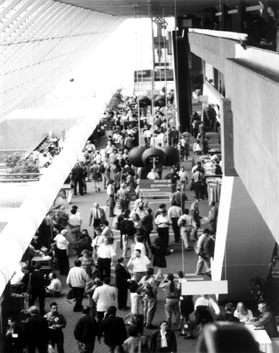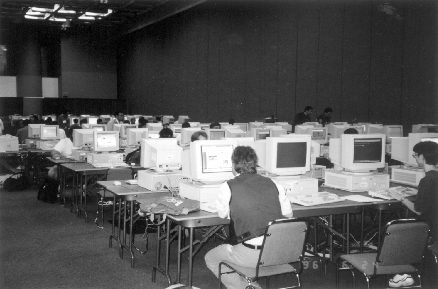
Visitor:
|
Shuichi Tashiro(Intelligent Communication Section,
Intelligent
System Division,
Electrotechnical
Laboratory) |
Period: June 20 - July 1, 1996 (12
days)
Places (attended conferences):
1) APAN (Asia Pacific Advanced
Network) Conference (Seoul)
2) IETF (Internet Engineering Task Force)
Conference (Montreal)
3) Inet '96 (Annual conference of the Internet Society)
(Montreal)
4) APNG (Asia Pacific Networking Group) Conference (Montreal)
Since the U.S. National Science Foundation (NSF) was in the process of
planning a new network project, several international meetings were scheduled
before and after the 1996 annual conference of the Internet Society (Inet '96),
including the APAN (Asia Pacific Advanced Network) conference held in Seoul,
Korea. This is a brief report on Inet '96 and the conference on Internet
Engineering Task Force (IETF), both held in Montreal, Canada, leaving the
details of other meetings to another report.
The venue for Inet '96 and the IETF conference was a convention center
located in downtown Montreal. The Inet is an annual program and IETF's
conference is held three times a year. This year two international events
happened to be held simultaneously at the same location for the first time.
Maybe because of the double-event nature, two conferences individually have own
characteristics; Inet '96 focused on discussions of social problems and the
current status, while the IETF conference concentrated on technical subjects.
The IETF is an international organization for technical discussions to
determine standards for the Internet and is therefore closely related with the
Internet Society, the host organization of Inet. The 1996 conference of the IETF
attracted some 1,400 participants from all over the world.
One of the hottest discussion subjects in the IETF conference is security.
Since the Internet was originally designed and has been developing as a network
for research and academic purposes, security used not to be the biggest concern.
Recent developments of new Internet applications including electronic commerce,
however, make it important to develop information privacy, authentication and
other security technologies quickly. At the IETF conference security at an IP
(Internet Protocol) level and network resource management like route control
were also actively discussed.
In addition to IETF conference, Inet '96 was also successful with more than
3,000 participants. Probably because the network industry is now a flourishing
business, the reception feature programs are getting larger and more spectacular
from year to year as they are funded by contributions from private companies.
Surprisingly, there was a circus performance for this year's conference on a
special stage built in the center of the conference hall.
The terminal room, a regular service of the conference, is also getting
larger. This year's terminal room was set up in a gymnasium-size hall with
hundreds of network terminals installed. Those terminals were of course
connected with the Internet so that I could easily access data at the
Electrotechnical Laboratory in Japan.
One of the popular topics concerning the Internet at Inet '96 was the
information delivery services for the Olympic Games in Atlanta. It was reported
at the conference that a new server distribution technology for reducing network
loads and a customization technology of WWW sites suited to individual users'
preferences had been developed and would be put into trial use.

Reception hall of the IETF/Inet'96
The driving force behind the rapid growth of the Internet may be the
popularity of the offered services, aggressive efforts being made to deliver
those services on a global scale, and to rapidly employ them as standards. I
felt for sure that such powerful features of the Internet were still intact.
Another conference entitled Asia Pacific Networking Group Conference (APNG)
was held at a hotel close to the convention center over the weekend. Discussed
at the APNG meeting were technological and strategic issues such as Internet
World Expo, multilingual services and regional interconnection circuits in Asia.
This was a special occasion of the IETF/Inet '96 as two major international
conferences were simultaneously held at the same venue, providing a special
opportunity and attracting Internet people to fly in to Montreal from all over
the world. During the IETF/Inet '96, participants tried to find the chance to
talk over matters related to the NSF's new project as I described at the
beginning of this report. From the breakfast in the morning to the after-dinner
gathering in the bar at night, almost all meal times were used as informal
discussion sessions.
It was an exciting and fruitful week. I found, however, that it may be a
problem that the huge scale conferences were held at the same time, as there
were too many sessions for individual participants to join all the programs that
they wanted to.

The terminal room(shown here is one quarter of the room


